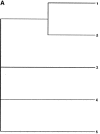Accuracy and power of statistical methods for detecting adaptive evolution in protein coding sequences and for identifying positively selected sites
- PMID: 15514074
- PMCID: PMC1448811
- DOI: 10.1534/genetics.104.031153
Accuracy and power of statistical methods for detecting adaptive evolution in protein coding sequences and for identifying positively selected sites
Abstract
The parsimony method of Suzuki and Gojobori (1999) and the maximum likelihood method developed from the work of Nielsen and Yang (1998) are two widely used methods for detecting positive selection in homologous protein coding sequences. Both methods consider an excess of nonsynonymous (replacement) substitutions as evidence for positive selection. Previously published simulation studies comparing the performance of the two methods show contradictory results. Here we conduct a more thorough simulation study to cover and extend the parameter space used in previous studies. We also reanalyzed an HLA data set that was previously proposed to cause problems when analyzed using the maximum likelihood method. Our new simulations and a reanalysis of the HLA data demonstrate that the maximum likelihood method has good power and accuracy in detecting positive selection over a wide range of parameter values. Previous studies reporting poor performance of the method appear to be due to numerical problems in the optimization algorithms and did not reflect the true performance of the method. The parsimony method has a very low rate of false positives but very little power for detecting positive selection or identifying positively selected sites.
Figures


References
-
- Anisimova, M., J. P. Bielawski and Z. Yang, 2001. Accuracy and power of the likelihood ratio test in detecting adaptive molecular evolution. Mol. Biol. Evol. 18: 1585–1592. - PubMed
-
- Anisimova, M., J. P. Bielawski and Z. Yang, 2002. Accuracy and power of bayes prediction of amino acid sites under positive selection. Mol. Biol. Evol. 19: 950–958. - PubMed
-
- Bernatchez, L., and C. Landry, 2003. MHC studies in nonmodel vertebrates: What have we learned about natural selection in 15 years? J. Evol. Biol. 16: 363–377. - PubMed
-
- Bjorkman, P. J., S. A. Saper, B. Samraoui, W. S. Bennet and J. L. Strominger et al., 1987. a Structure of the class I histocompatibility antigen, HLA-A2. Nature 329: 506–512. - PubMed
Publication types
MeSH terms
Substances
Grants and funding
LinkOut - more resources
Full Text Sources
Research Materials

